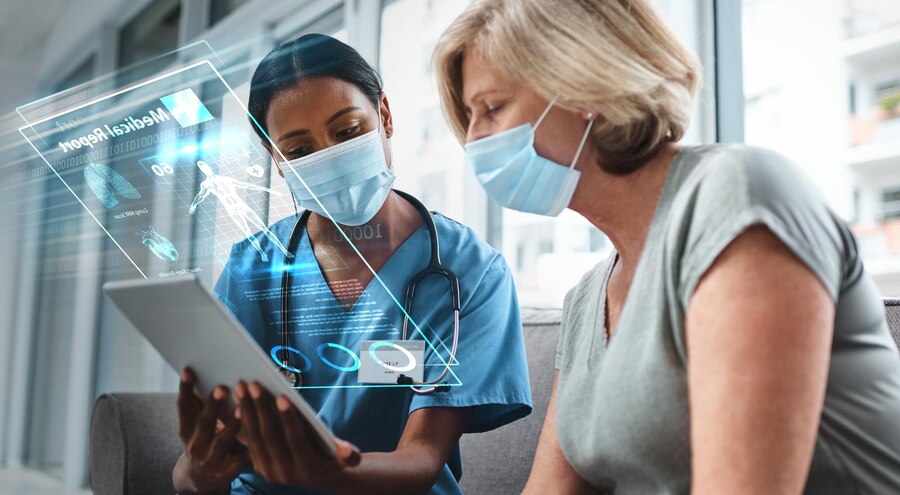Luka Wright
09, February 2024
Advancements in healthcare for the last decade have continuously improved, saving the lives of millions of people. However, despite being one of the most rapidly growing industries in modern society, the healthcare sector still finds many patients struggling to find the personalized healthcare they need.
There are many different evolving technologies attempting to bridge this gap between patient and provider, and The Internet of Things (IoT) is no different. IoT refers to the network of interconnected devices that communicate and share data seamlessly. It has emerged as a revolutionary force, transforming various industries, including the healthcare sector. A subset of IoT technology, known as the Internet of Healthcare Things (IoHT) or the Internet of Medical Things (IoMT), has led to transformative changes; improving patient care, enhancing efficiency, and revolutionizing medical practices.
Here at Greycode, we are focused on researching the different ways IoT can offer solutions. Let’s look at IoHT in practise, how it’s used currently and the future of IoT within the healthcare industry.
Four stages of Internet of Healthcare Things (IoHT)
The Internet of Healthcare Things (IoHT) operates through a structured process involving four key stages. This four-stage process is carefully designed to capture, process, and utilize healthcare data in a seamless and efficient manner. Here is an overview of how the IoHT works:
Stage 1: Device Deployment
- Sensors and Devices: The process begins with the deployment of various interconnected devices within healthcare facilities. These devices include a wide array of sensors, medical equipment, monitors, detectors, and camera systems that are strategically placed to collect valuable and relevant data. These devices serve as the foundation for creating a networked healthcare environment.
- Data Collection: The devices continuously collect data in real-time, monitoring patient vital signs, environmental conditions, and equipment statuses. The primary goal of this stage is to establish a comprehensive structure for data collection that forms the basis for subsequent stages. The gathered data forms the foundation for generating insights and making informed decisions.
Stage 2: Data Digitization
- Aggregation and Conversion: Once the analogue data is obtained from sensors and devices, it is aggregated, processed, and converted into a digital format. This digitization process ensures involves transforming raw sensor data into a structured and standardized form, making it compatible with digital systems.
- Standardization: Data standardization is performed to ensure consistency, compatibility and interoperability across different types of devices and systems. This stage is critical for creating a standardized dataset that can be efficiently managed and operated.
Stage 3: Cloud Migration
- Pre-processing: Before transferring data to the cloud, pre-processing is conducted to clean and filter the information. This step involves removing irrelevant data, correcting errors, and ensuring data is ready for advanced analytics.
- Transfer to Cloud: Once pre-processed, the digitized data is transferred to cloud data centers. Cloud computing provides a scalable and secure environment for storing, managing, and processing large volumes of healthcare data. Cloud migration enhances accessibility, facilitates real-time collaboration, and allows healthcare providers to leverage the benefits of centralized storage and computing resources.
Stage 4: Insight Extraction
- Advanced Analytics: In the final stage, advanced analytics techniques are applied to the data stored in the cloud. This includes machine learning algorithms, artificial intelligence, and data mining. These analytics tools help uncover patterns, correlations, and trends within the data.
- Actionable Insights: The insights extracted from the data can be used for various purposes, such as predictive modelling, risk assessment, personalized patient care, and decision support. Healthcare professionals can make data-driven decisions to optimize treatment plans, improve patient outcomes, and enhance overall healthcare delivery.
The four stages of the Internet of Healthcare Things represent a progressive journey towards creating a connected, data-driven healthcare ecosystem. From the initial deployment of interconnected devices to the extraction of actionable insights through advanced analytics, each stage plays a crucial role in harnessing the power of IoHT. As technology continues to advance, the integration of IoHT is expected to drive further innovation, improve patient care, and contribute to the ongoing transformation of the healthcare industry.
Examples of IoT in Healthcare Use Cases
The implementation of IoT within the healthcare industry has improved many of the processes in the last few years, and has a lot of potential to improve the way the systems operate in the future. New and innovative inventions are created every day in order to improve the healthcare industry. Some basic operations, such as hardware maintenance, is already available and used by many. Here are some of the essential use cases for IoT within the healthcare sector as utilized in many current healthcare facilities:
IoT-Enabled Automated Patient Check-In
Traditionally, patient check-in processes involve paperwork, manual verification, and queuing at registration desks; leading to long and unnecessary waiting times. With IoT-enabled patient check-in systems, individuals can complete necessary forms electronically before arriving at the healthcare facility. This online capture of a patient’s information should also make it much easier to transfer to a different doctor or hospital. This not only expedites the registration process but also minimizes paperwork-related delays, allowing patients to move seamlessly through the initial stages of their healthcare journey.
Hardware Maintenance
In the healthcare industry, one of IoT’s most important use cases is keeping hardware updated and maintained. Within hospitals, each and every device plays a crucial role in ensuring patients get the care they deserve. Imagine a hospital with hundreds of pieces of medical equipment, all working in harmony to achieve the desired effect - it would be impractical for the staff to keep track of each piece of equipment and when they were last serviced.
IoHT plays a crucial role in addressing this challenge, particularly in the tracking and proper maintenance of hardware. This helps ensure that all of the equipment is properly preserved and would also help reduce the risk of breakdowns. In critical settings like hospitals, where timely and reliable equipment operation is a matter of literal life and death, IoHT emerges as a transformative solution.
Conclusion
In conclusion, the future of IoT in healthcare is characterized by continued growth and technological advancements, which can hopefully shift toward a more patient-centric and digitally enabled healthcare solutions. From remote patient monitoring to predictive analytics, the advantages are evident - improved patient outcomes, reduced costs, operational efficiency, and a more proactive approach to healthcare. At Greycode, we are continuously conducting research and diving into IoT development and solutions for all sectors. We are hard at work to find the next big project and we’re looking forward to seeing the developments of the future. As technology continues to advance, the role of IoT in healthcare is poised to expand even further, ushering in an era of unprecedented innovation and progress in the quest for better health and well-being.

.jpg)


.png)

.png)


